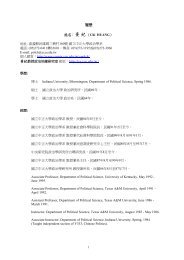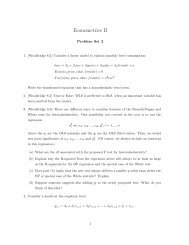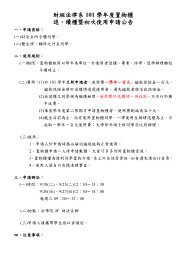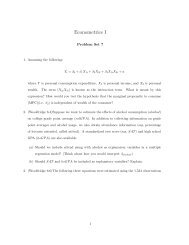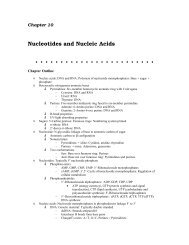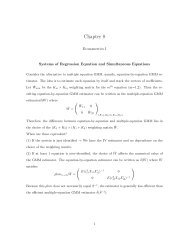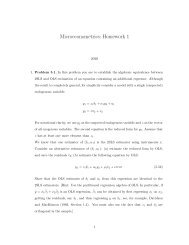Create successful ePaper yourself
Turn your PDF publications into a flip-book with our unique Google optimized e-Paper software.
Chapter 4 . <strong>Amino</strong> <strong>Acids</strong><br />
+H 3N<br />
H<br />
COO-<br />
C<br />
C<br />
H<br />
CH 3<br />
OH<br />
H<br />
HO<br />
COO-<br />
C<br />
C<br />
CH 3<br />
NH 3+<br />
H<br />
58<br />
+H 3N<br />
COO-<br />
C<br />
C<br />
CH 3<br />
H<br />
H<br />
H<br />
COO-<br />
C<br />
C<br />
CH 3<br />
NH 3+<br />
L-Threonine D-Threonine L-Allothreonine D-Allothreonine<br />
By inspection we see that<br />
L-threonine is (2S, 3R) threonine<br />
D-threonine is (2R,3S) threonine<br />
L-allothreonine is (2S,3S) threonine<br />
D-allothreonine is (2R,3R) threonine<br />
Questions for Self Study<br />
1. Fill in the blanks: A bond is an amide bond between two . The bond is formed by a<br />
reaction between the of one amino acid and the of a second amino acid with the<br />
elimination of the elements of . The result is a linear chain with an end and a end.<br />
The chain can be extended into a polymer with additional amino acids. The polymer formed is<br />
called either a or a depending on the number of amino acids joined. The amide bond<br />
can be broken by the addition of the elements of water across it in a reaction.<br />
2. List the four classes of amino acids.<br />
3. Indicate which class of amino acids best represents the statements presented below:<br />
a. Their side chain may contain a hydroxyl group. .<br />
b. Negatively charged at basic pH. .<br />
c. Relatively poorly soluble in aqueous solution. .<br />
d. Relatively soluble in aqueous solution. .<br />
e. Positively charged at acidic pH. .<br />
f. Side chains are capable of hydrogen bonding. .<br />
g. Includes the amino acids arginine, histidine and lysine. .<br />
h. Side chains contain predominantly hydrocarbons._____<br />
i. Side chains are responsible for the hydrophobic cores of globular proteins. .<br />
j. The amides of glutamic and aspartic acid belong to this group. .<br />
4. From the list of amino acids presented indicate which one best fits the description:<br />
a. The smallest amino acid (It also lacks a stereoisomer).<br />
alanine, glycine, phenylalanine, glutamine<br />
b. An aromatic amino acid.<br />
glutamic acid, tyrosine, isoleucine, proline<br />
c. A sulfur-containing amino acid.<br />
methionine, aspartic acid, arginine, leucine<br />
d. An amino acid capable of forming sulfur-sulfur bonds.<br />
methionine, proline, cysteine, tryptophan<br />
e. A branched chain amino acid.<br />
methionine, leucine, aspartic acid, asparagine<br />
5. Fill in the blanks. Most of the amino acids are chiral compounds because they have at least<br />
one carbon atom with different groups attached. Thus, there are ways of arranging the<br />
four groups about the carbon atom. For the case of an amino acid with a single asymmetric<br />
carbon, the isomers pairs that can be formed are called ; they are nonsuperimposable, .<br />
images of each other. Using the D,L system of nomenclature, the commonly occurring amino<br />
acids are all amino acids.<br />
6. Which three amino acids absorb light in the ultraviolet region of the spectrum above 250<br />
nm?<br />
HO<br />
H<br />
OH





